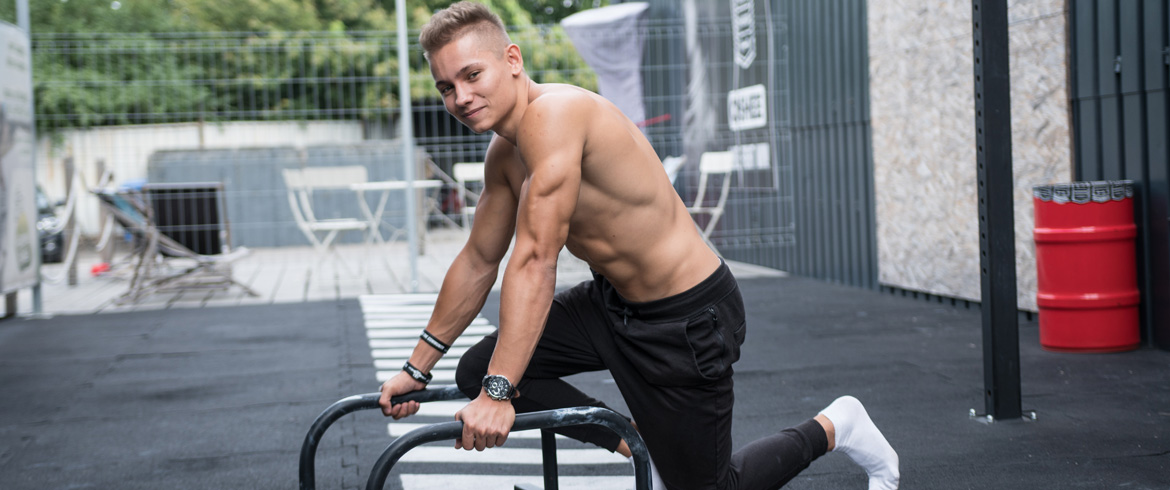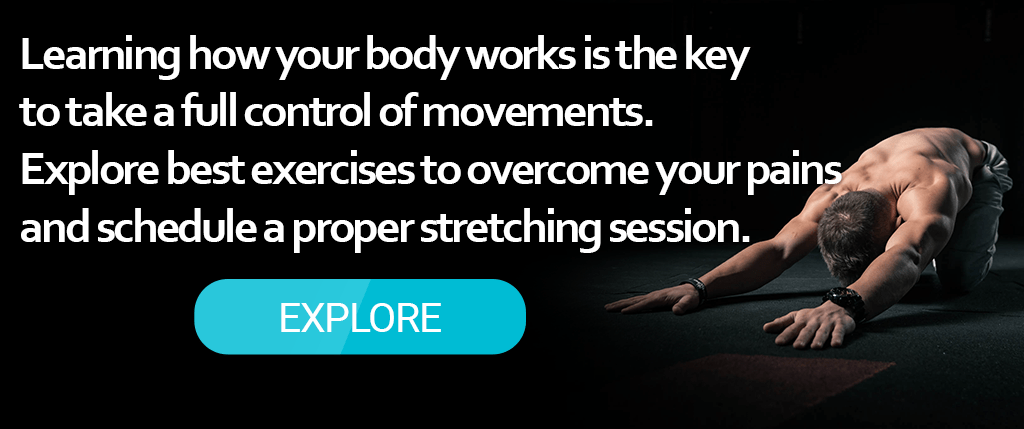
Knee pain – not on our watch!
First of all, remember that this article cannot replace consulting with a specialist, especially when your knee pain is persistent and severe. Please talk to your physician or PT specialist as well. That said, you should know that you don’t have to put up with knee pain. There are some ways to fight it, either with knee strengthening exercises, stretches, or – more precise – knee pain relief exercises. But before we get to all that, let’s go back to the basics – why does it hurt at all? And what hurts? I know, the knee, right? But more specifically
1. What’s behind your knee pain?
It may be a bit complicated – looking at the knee anatomy and all – but it’s also crucial for understanding the source of most cases of knee pain. Of course, we’re not talking about traumatic knee injuries at the moment, just the pain that occurs during or after a workout. For better understanding, it’s best to know something about the knee parts. The knee is built so it can bend and straighten. So it would be best if all the excessive rotation of the knees was avoided, but of course, that’s not entirely possible. Fortunately, in the knee itself, there are parts that stabilize it during sliding, rotation or side to side movement. They are called ligaments and menisci.
Their function is slightly different: ligaments stabilize the joint and menisci cushion it and absorb the forces that impact it. Then there’s a kneecap (called patella) that improves the leverage of the quadriceps muscles and increases the amount of force they can generate on the tibia (as one of two calf bones, the second is called femur). Then there’s a whole bunch of muscles that are interacting with the knee. I’ll spare you most of the knee muscles names as they’re a mouthful and stick just to thigh muscles: quadriceps and hamstrings and – calf muscles – gastrocnemius and soleus. And there are also tendons called pes anserine. And that’s it – knee anatomy in a shell.

So, what are the most common of knee injuries?
- “Crunchy knees”: happen when movement at the patella is not optimal. It causes some irritations to the underside of the bone and at the patellar tendon.
- Related to crunchy knees is patellar tendinitis, also known as “the jumper’s knee”. The source of pain lies at the place where the tendons are attached at the tibia. There are four stages of this condition, and the classification is made based on a duration of the symptoms. Stage 1 is when the pain occurs only after a workout, and it doesn’t influence the functioning of the knee. Stage 2 begins when you feel the pain also during the activity but still can perform all the exercises you want. Stage 3 means that the pain during and after your routine lasts longer and stops you from doing everything that you’ve planned. And there’s a stage 4 – tendon tear that can be only repaired surgically.
- A problem in a place where patella contacts the femur is also a source of pain and discomfort. This condition (along with several others connected with the patella) is called “the runner’s knee”.
- Moreover, all of the muscles interacting with the knee should be strong, flexible and generally function well. Otherwise, the knee cannot function the way it’s supposed to, and that leads to injuries.
And what are the knee pain causes?
Problems with ligaments and muscles or tendons occur when the knee experience excessive forces, not only when something hits it or tackles it – it may happen during jumping or running. And the main thing is, when it happens to you, it doesn’t necessarily mean that you’ve been exercising too much. You can also have abnormal habitual movements – in other words, you do your exercises wrong, so here’s the room for some improvement. But first, let’s see what can be done with existing knee pain.
 2. What to do when it hurts
2. What to do when it hurts
Now we know the main sources of knee problems – muscles/ tendons and patella. So the first thing one should do when experiencing the knee pain is to work on those two. There are two problems with the muscles – they are either too weak or too tight, so the knee pain exercises will, of course, consist of strengthening and stretching. Yes, in this very order. It is unwise, to begin with, the stretches because the stronger muscles tend to compensate for the weaker ones so the problem will only deepen. But first of all, let’s look at some knee pain relief exercises. Because here’s another important thing: do not work out through your pain! Don’t focus on being better and better and doing more and more reps. When it hurts, stop. Do not overstrain already strained muscles.
1. Knee pain relief exercises

- You can exercise with a resistance band. Put it around your ankles (if you have a spare one, you can put it slightly above your knees) and start stepping sideways with one foot and then the other. Do it in a half-squat position, do not let the knees cave in and keep the weight on your heels. You can also do a forward/ backward version.
- Supermans: lie on your stomach and simultaneously lift your left arm and right foot. Give it a moment, then switch leg and arm.

- Ball between legs: lie on your back and put an exercise ball between your legs. Rise your lags and start putting your legs on the left and right side. Keep your lower back on the ground all the time!
- Tuck squats and elevated split squats: you can do the squats with your bottom touching the bench (but not resting on it) or put one leg on the bench and do the squats on the other one
Give it time. Your knee should work better after six or eight weeks of such a routine. After that, you may proceed to the other exercises.
2. Leg strengthening
You can strengthen your legs in many ways, and there are hundreds of exercise to pick and choose from. Here it’s only but a sample, that covers the essential muscles in knee pain relief workout: quads and hamstring (for obvious reasons – they straighten and bend the leg), glutes (help control the previous ones) and calf (helps with foot control)
- Quads strengthening: lay on your back with legs straight. Start tightening the front of the thigh by putting your knee down. You can also do a straight leg rise: lay on your back with working leg straight and the other bent with the foot on the floor. Put your toes toward you and lock your knee straight. Rise the straight leg and after 3-5 seconds slowly lower it down. These two are great exercises as they do not put any stress on the knee itself.
- Hamstring strengthening: sit on a chair with your heels touching the chair legs. Feet on a floor. Start pressing the heels into the chair legs, and you feel the back of your thigh tighten. Hold it for 3-5 seconds. Do not move your feet during the exercise. And here’s another one: lay on your stomach and slowly lift one foot and touch your bottom with the heel, if you can that is. There’s a similar exercise when you’re standing and holding on to something while moving your foot to the bottom and back one after the other.
- Glutes strengthening: when sitting or lying on your back, clench your buttocks and hold it for 3 seconds. After that, you can lie on your back with hips and knees bent at 90°. Then lift your top knee as high as you can and hold for three seconds. Keep your feet together, squeezing the heels for better effect.
- Calf strengthening: stand with your feet apart, then lift your heels as high as possible with your body straight. Hold for 3-5 seconds and lower.
3. Stretches for knee pain
When your weak muscles gained some strength, you can proceed to stretch them
- Quads stretch: stand on one foot and hold on to something for balance. Grab one leg by the ankle and pull it to your bottom. Hold for 30 seconds. You can also do the version when you’re lying on your side with your body in a straight line.
- Hamstring stretches: sit on the edge of a chair. On feet on a floor. The second leg stretched out with a slightly bent knee. Lean forward until you feel the stretch in the back of your thigh. Do the standing version as well.
- Glutes stretch: sit in a chair with one foot on the other’s leg knee. Gently lean forward and hold the stretch for 30 seconds.
- Calf stretches: hold on to a wall with your toes pointing straight forward. Place the leg to be stretched behind you and lean forward. Hold the stretch for 30 seconds.
4. Want something more?
While the best way to get rid of your knee pain is to target the knee muscles and knee-cap specifically, it’s also helpful to do some general strengthening exercises and work on your hips and ankles. And then there are some other leg exercises. Then you can start to practice the knee movements, to prepare your knees for some unusual activity. Try doing the knee circles (with knees together and apart), then do some balancing on one leg. Proceed to jump landing control – do short jumps, land on the balls of your feet. Practice one and two legs jump.
And finally – what about the other exercises? With your strengthened knees you can start planning your routine. But the key to preventing future injuries is mastering workout. Try doing all the exercises in their proper form to minimize the pressure put on your knees.
